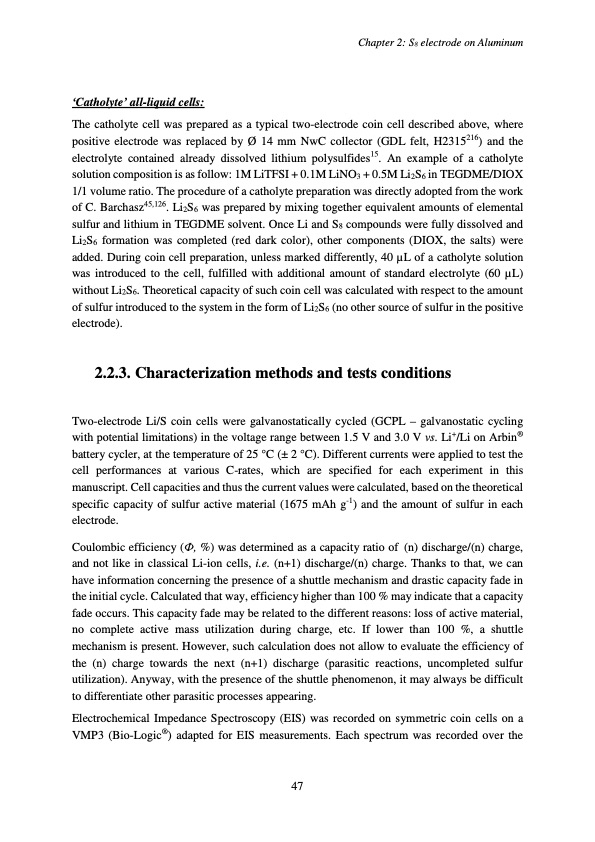
PDF Publication Title:
Text from PDF Page: 051
‘Catholyte’ all-liquid cells: The catholyte cell was prepared as a typical two-electrode coin cell described above, where positive electrode was replaced by Ø 14 mm NwC collector (GDL felt, H2315216) and the electrolyte contained already dissolved lithium polysulfides15. An example of a catholyte solution composition is as follow: 1M LiTFSI + 0.1M LiNO3 + 0.5M Li2S6 in TEGDME/DIOX 1/1 volume ratio. The procedure of a catholyte preparation was directly adopted from the work of C. Barchasz45,126. Li2S6 was prepared by mixing together equivalent amounts of elemental sulfur and lithium in TEGDME solvent. Once Li and S8 compounds were fully dissolved and Li2S6 formation was completed (red dark color), other components (DIOX, the salts) were added. During coin cell preparation, unless marked differently, 40 μL of a catholyte solution was introduced to the cell, fulfilled with additional amount of standard electrolyte (60 μL) without Li2S6. Theoretical capacity of such coin cell was calculated with respect to the amount of sulfur introduced to the system in the form of Li2S6 (no other source of sulfur in the positive electrode). 2.2.3. Characterization methods and tests conditions Two-electrode Li/S coin cells were galvanostatically cycled (GCPL – galvanostatic cycling with potential limitations) in the voltage range between 1.5 V and 3.0 V vs. Li+/Li on Arbin® battery cycler, at the temperature of 25 °C (± 2 °C). Different currents were applied to test the cell performances at various C-rates, which are specified for each experiment in this manuscript. Cell capacities and thus the current values were calculated, based on the theoretical specific capacity of sulfur active material (1675 mAh g-1) and the amount of sulfur in each electrode. Coulombic efficiency (Ф, %) was determined as a capacity ratio of (n) discharge/(n) charge, and not like in classical Li-ion cells, i.e. (n+1) discharge/(n) charge. Thanks to that, we can have information concerning the presence of a shuttle mechanism and drastic capacity fade in the initial cycle. Calculated that way, efficiency higher than 100 % may indicate that a capacity fade occurs. This capacity fade may be related to the different reasons: loss of active material, no complete active mass utilization during charge, etc. If lower than 100 %, a shuttle mechanism is present. However, such calculation does not allow to evaluate the efficiency of the (n) charge towards the next (n+1) discharge (parasitic reactions, uncompleted sulfur utilization). Anyway, with the presence of the shuttle phenomenon, it may always be difficult to differentiate other parasitic processes appearing. Electrochemical Impedance Spectroscopy (EIS) was recorded on symmetric coin cells on a VMP3 (Bio-Logic®) adapted for EIS measurements. Each spectrum was recorded over the Chapter 2: S8 electrode on Aluminum 47PDF Image | Accumulateur Lithium Soufre

PDF Search Title:
Accumulateur Lithium SoufreOriginal File Name Searched:
WALUS_2015_archivage.pdfDIY PDF Search: Google It | Yahoo | Bing
Sulfur Deposition on Carbon Nanofibers using Supercritical CO2 Sulfur Deposition on Carbon Nanofibers using Supercritical CO2. Gamma sulfur also known as mother of pearl sulfur and nacreous sulfur... More Info
CO2 Organic Rankine Cycle Experimenter Platform The supercritical CO2 phase change system is both a heat pump and organic rankine cycle which can be used for those purposes and as a supercritical extractor for advanced subcritical and supercritical extraction technology. Uses include producing nanoparticles, precious metal CO2 extraction, lithium battery recycling, and other applications... More Info
| CONTACT TEL: 608-238-6001 Email: greg@infinityturbine.com | RSS | AMP |